The Capricorn Orogen project mapping teams have carried out geoscientific investigations including detailed mapping at the 1:100 000 scale, to advance our understanding of the Proterozoic Capricorn Orogen, including its tectonic evolution and prospectivity.
Basement rocks of the Gascoyne Province and the overlying sedimentary rocks of the Edmund and Collier Basins were first systematically mapped by the Geological Survey of Western Australia (GSWA) in the 1960s and 1970s. Products from this program included 1:250 000 scale maps and Explanatory Notes, and a number of early Reports. Systematic 1:100 000 scale field mapping from 1996 to 2017 has produced over 44 first and second edition printed maps, Explanatory Notes for all lithostratigraphic units and events, as well as numerous Reports and Records outlining the protracted tectonic history of this part of the Orogen. The province and basins are covered by recent aeromagnetic and radiometric data at 400 m line spacing, 2.5 km spaced gravity, and Landsat TM and DEM-derived imagery, as well as crustal-scale geophysical data including seismic reflection and magnetotelluric (MT) data, and regional-scale passive seismic data. Together with abundant SHRIMP U–Pb zircon, monazite and xenotime geochronology, whole-rock and mineral isotope geochemistry, and whole-rock lithogeochemistry, these data help define the tectonic, depositional and mineralization history of the Orogen.
Links to GSWA’s and other publications are provided below. The Capricorn Orogen 2016 Geological Information Series package is the most up-to-date compilation for the project.
Tectonic evolution of the Capricorn Orogen
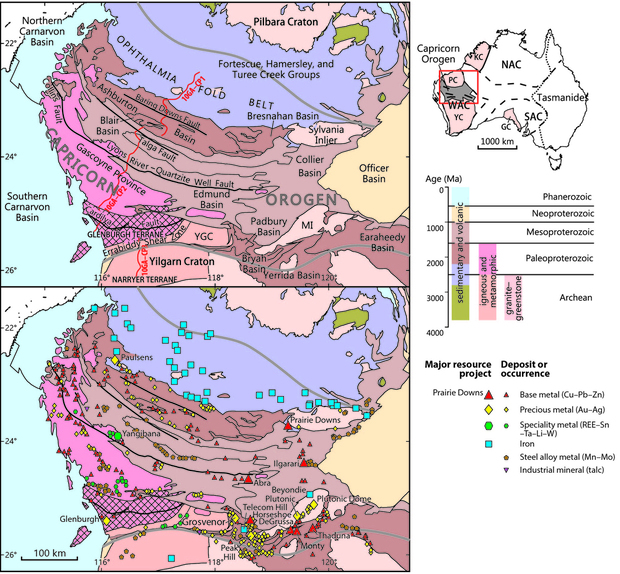
The Capricorn Orogen of Western Australia is a ~ 1000 km long, 500 km wide region of variably deformed Archean to Proterozoic rocks located between the Pilbara and Yilgarn Cratons. The orogen records the punctuated Paleoproterozoic assembly of these two cratons, as well as an exotic Archean to Paleoproterozoic continental fragment — the Glenburgh Terrane of the Gascoyne Province — to form the West Australian Craton, as well as over one billion years of subsequent intracratonic reworking and reactivation. The orogen includes the deformed margins of the Pilbara and Yilgarn Cratons and associated continental margin rocks of the Fortescue, Hamersley, Turee Creek and Shingle Creek Groups; medium- to high-grade meta-igneous and metasedimentary rocks of the Gascoyne Province; and various low-grade (meta)sedimentary rocks including the Wyloo, Bresnahan, Mount Minnie, Padbury, Bryah, Yerrida, Earaheedy, Edmund and Collier Groups.
Collision between the Pilbara Craton and the Glenburgh Terrane occurred during the 2215–2145 Ma Ophthalmia Orogeny while assembly of the West Australian Craton was completed during the 2005–1950 Ma Glenburgh Orogeny when the combined Pilbara–Glenburgh block collided with the Yilgarn Craton. The orogen was subject to repeated reworking and reactivation during the 1817–1772 Ma Capricorn Orogeny, the 1680–1620 Ma Mangaroon Orogeny, the 1321–1171 Ma Mutherbukin Tectonic Event, the 1026–954 Ma Edmundian Orogeny, the 931–749 Ma Kuparr Tectonic Event, and the c. 570 Ma Mulka Tectonic Event.
Despite the widespread abundance of gold, base metal and rare earth element occurrences throughout the Orogen, the region has few working mines. However, over the past decade there have been significant discoveries such as the world-class Cu–Au–Ag DeGrussa deposit in the east. A recent deep crustal seismic reflection survey across the Orogen, as well as numerous other geophysical surveys, have led to a growing understanding of the relationship between the deep crustal architecture and the location and setting of the ore deposits. These studies have identified several discrete crustal blocks that are exposed at the surface, including the Pilbara and Yilgarn Cratons, and the Glenburgh Terrane, as well as several unexposed deep crustal terranes, including the Bandee and MacAdam Seismic Provinces. These discrete tectonic blocks are sutured along three major crustal structures — the Cardilya, Lyons River and Baring Downs Faults — which most likely represent collisional suture zones associated with the assembly of the West Australian Craton. The location and orientation of these collision-related structures appear to have fundamentally controlled all subsequent intraplate reworking events, including the style and orientation of deformation, as well as the location of magmatism, sedimentation and mineralization.
The Gascoyne Province
The Gascoyne Province forms the medium- to high-grade metamorphic core of the orogen. The oldest component is the Glenburgh Terrane, interpreted to be an exotic microcontinent. The terrane comprises heterogeneous granitic gneisses of the 2555–2430 Ma Halfway Gneiss and voluminous intermediate to granitic rocks of the 2005–1975 Ma Dalgaringa Supersuite, which forms an extensive granite batholith along the southern margin of the terrane. The Dalgaringa Supersuite magmatic rocks are interpreted to have been generated in a continental margin arc setting along the (present-day) southern margin of the terrane during the final amalgamation of the West Australian Craton. Following the assembly of the West Australian Craton, the province was structurally and thermally reworked during at least five punctuated intraplate orogenic events over a period of more than one billion years. Many of the events were accompanied by the intrusion of voluminous syntectonic felsic magmatic rocks. Granitic rocks associated with the Capricorn, Mangaroon and Edmundian Orogenies show similar calc-alkaline geochemical signatures and were generated and emplaced entirely within an intraplate tectonic setting. The protracted crustal reworking history of the Province has led to a highly differentiated orogenic crust, whereby the shallow portion has been enriched in high-heat producing elements such as U, Th and K, resulting in warmer crustal geotherms that may have weakened the lithosphere, making the orogen more susceptible to intraplate reworking.

The Edmund and Collier Basins
The 1679–1067 Ma Edmund and Collier Basins are the youngest depositional elements of the Capricorn Orogen and contain 4–12 km of siliciclastic, carbonate and minor volcaniclastic sedimentary rocks deposited in a variety of fluvial to deep-marine environments. The rocks have been divided into six informal depositional packages, each defined by basal unconformities or major marine flooding surfaces and are the result of differential fault movements or fluctuations in sea level. Voluminous mafic sills were intruded into the basins at various times, locally inflating the stratigraphic thickness by up to 60%. The Edmund Group was intruded by the Waldburg and Narimbunna Dolerites, and the Edmund and Collier Groups were both intruded by the c. 1070 Ma Kulkatharra Dolerite.
The Edmund Basin has a half-graben architecture formed by the normal reactivation of older basement faults and sutures during the latter part of the Mangaroon Orogeny. Regional-scale extension during this time period has been calculated at ~ 7–8%. Paleocurrent directions and detrital zircon studies show that sediment supply was largely from the north. The Edmund Group sedimentary rocks were deformed during the Mutherbukin Tectonic Event prior to the deposition of the overlying Collier Group. The architecture of the Collier Basin is still poorly known, but the age and isotopic composition of detrital zircons indicate that the sediments were sourced directly from the underlying rocks of the Edmund Basin. Both groups were deformed during the Edmundian Orogeny, the Kuparr Event, and the Mulka Tectonic Event. Total regional-scale shortening during all postdepositional orogenic events is calculated at ~ 21%.
The Edmund and Collier Basins contain a wide range of mineral occurrences including supergene manganese and lead, minor gold and phosphate, as well as Western Australia's largest stratabound Pb–Ag–Cu–Au deposit at Abra. Many of these deposits are associated with major crustal-scale faults that have been reactivated multiple times.
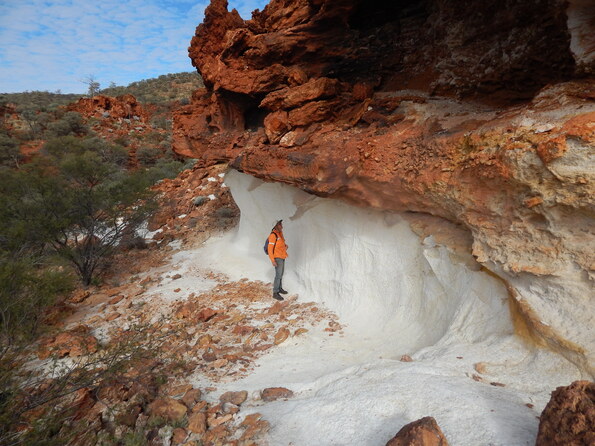
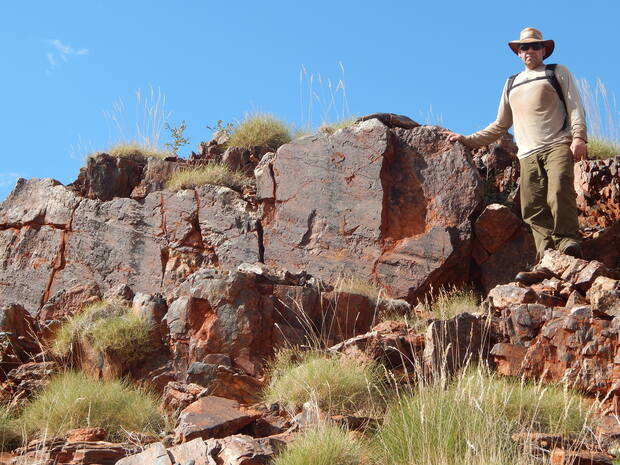
Explanatory Notes
Detailed descriptions of all lithological units and tectonic events in the Capricorn orogeny can be accessed through the Explanatory Notes System (ENS).
Reports
-
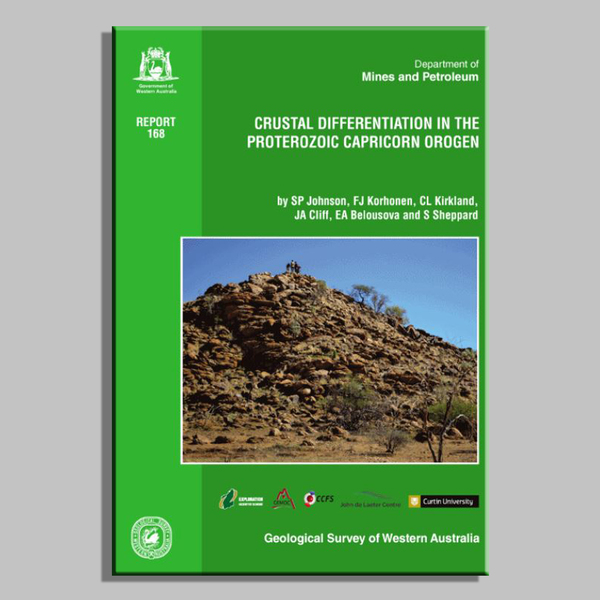 Report 168
Crustal differentiation in the Proterozoic Capricorn Orogen
Report 168
Crustal differentiation in the Proterozoic Capricorn Orogen
-
 Report 168 Data
Additional data for Report 168: Crustal differentiation in the Proterozoic Capricorn Orogen
Report 168 Data
Additional data for Report 168: Crustal differentiation in the Proterozoic Capricorn Orogen
-
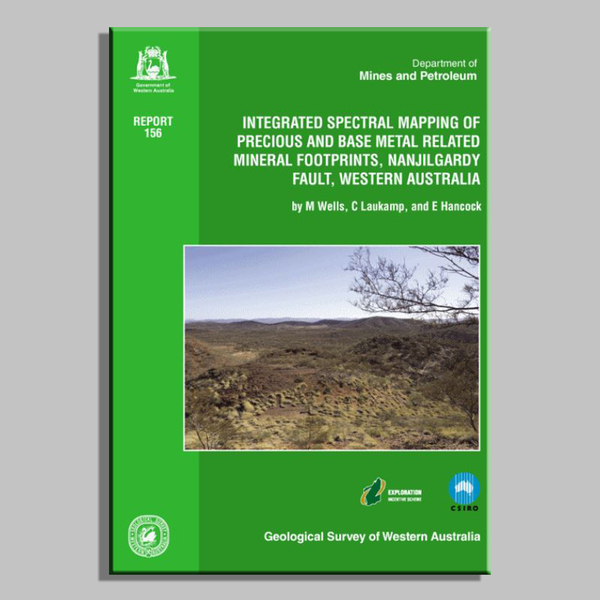 Report 156
Integrated spectral mapping of precious and base mental related mineral footprints, Nanjilgardy Fault, Western Australia
Report 156
Integrated spectral mapping of precious and base mental related mineral footprints, Nanjilgardy Fault, Western Australia
-
 Report 155
Unravelling the upper-amphibolite facies Glenburgh gold deposit, Gascoyne Province — evidence for metamorphosed mineralization
Report 155
Unravelling the upper-amphibolite facies Glenburgh gold deposit, Gascoyne Province — evidence for metamorphosed mineralization
-
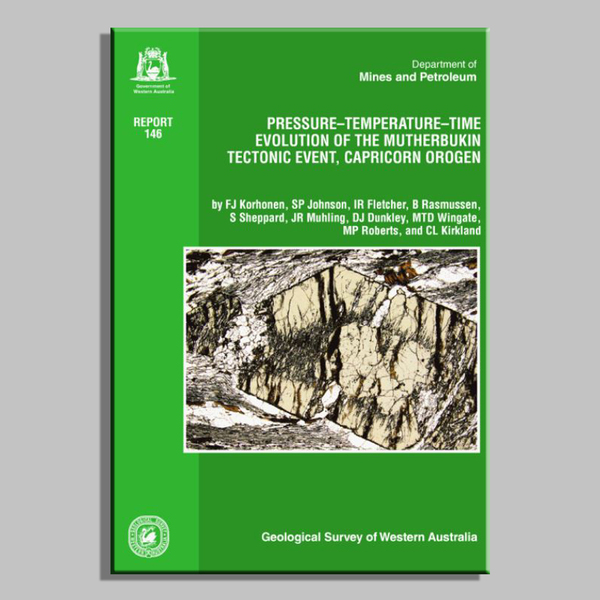 Report 146
Pressure–temperature–time evolution of the Mutherbukin Tectonic Event, Capricorn Orogen
Report 146
Pressure–temperature–time evolution of the Mutherbukin Tectonic Event, Capricorn Orogen
-
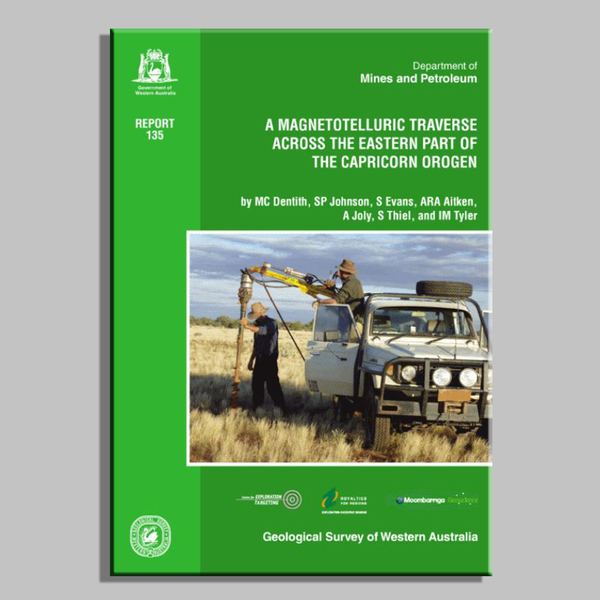 Report 135
A magnetotelluric traverse across the eastern part of the Capricorn Orogen
Report 135
A magnetotelluric traverse across the eastern part of the Capricorn Orogen
-
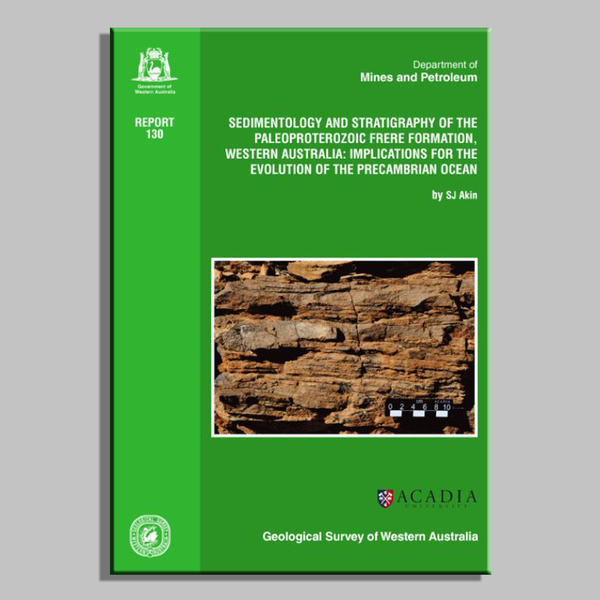 Report 130
Sedimentology and stratigraphy of the Paleoproterozoic Frere Formation, Western Australia
Report 130
Sedimentology and stratigraphy of the Paleoproterozoic Frere Formation, Western Australia
-
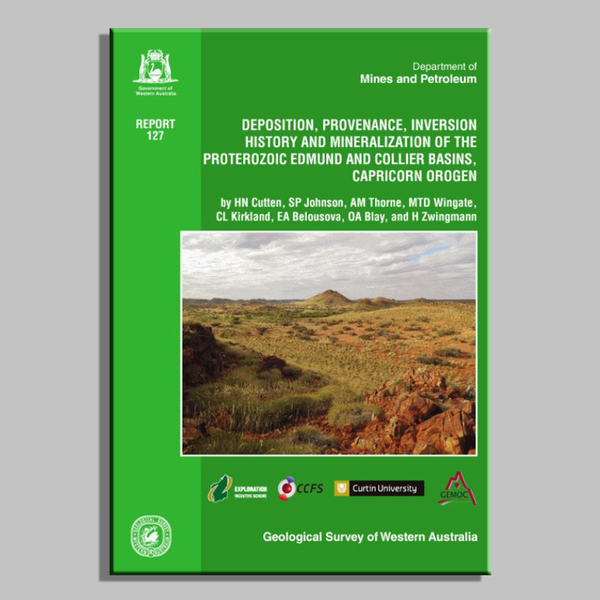 Report 127
Deposition, provenance, inversion history and mineralization of the Proterozoic Edmund and Collier Basins, Capricorn Orogen
Report 127
Deposition, provenance, inversion history and mineralization of the Proterozoic Edmund and Collier Basins, Capricorn Orogen
-
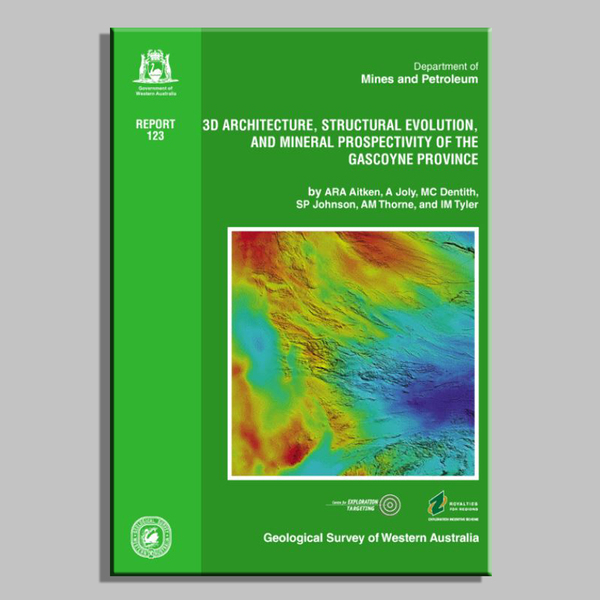 Report 123
3D architecture, structural evolution, and mineral prospectivity of the Gascoyne Province
Report 123
3D architecture, structural evolution, and mineral prospectivity of the Gascoyne Province
-
 Report 123 Data
Additional data for Report 123: 3D architecture, structural evolution, and mineral prospectivity of the Gascoyne Province
Report 123 Data
Additional data for Report 123: 3D architecture, structural evolution, and mineral prospectivity of the Gascoyne Province
-
 Report 110
Temporal and hafnium isotopic evolution of the Glenburgh Terrane basement: an exotic crustal fragment in the Capricorn Orogen
Report 110
Temporal and hafnium isotopic evolution of the Glenburgh Terrane basement: an exotic crustal fragment in the Capricorn Orogen
-
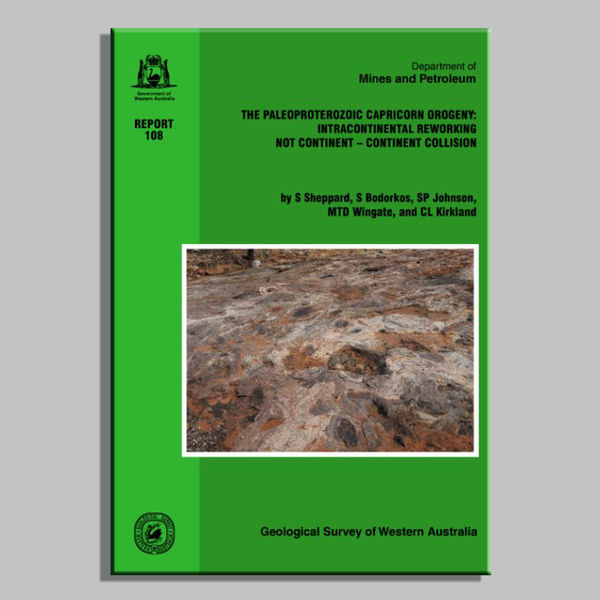 Report 108
The Paleoproterozoic Capricorn Orogeny: intracontinental reworking not continent–continent collision
Report 108
The Paleoproterozoic Capricorn Orogeny: intracontinental reworking not continent–continent collision
-
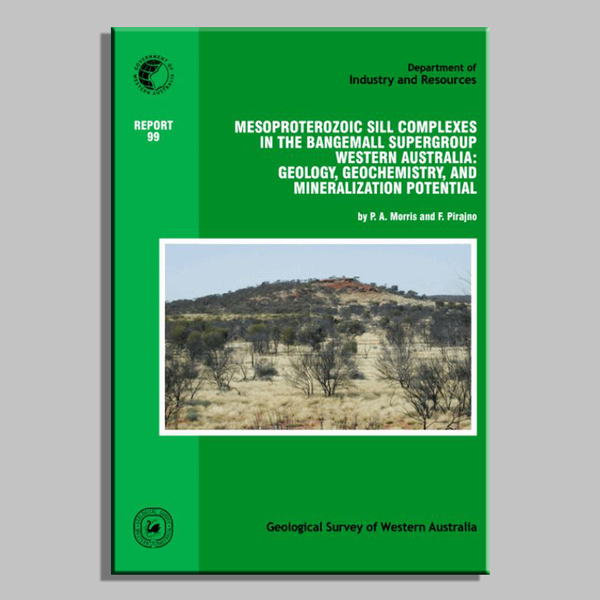 Report 99
Mesoproterozoic Sill complexes in the Bangemall Supergroup, Western Australia: geology, geochemistry, and mineralization potential
Report 99
Mesoproterozoic Sill complexes in the Bangemall Supergroup, Western Australia: geology, geochemistry, and mineralization potential
-
 Report 96
Mineral occurrences and exploration potential of the Earaheedy area, Western Australia
Report 96
Mineral occurrences and exploration potential of the Earaheedy area, Western Australia
-
 Report 82
Geology of the Shoemaker impact structure, Western Australia
Report 82
Geology of the Shoemaker impact structure, Western Australia
-
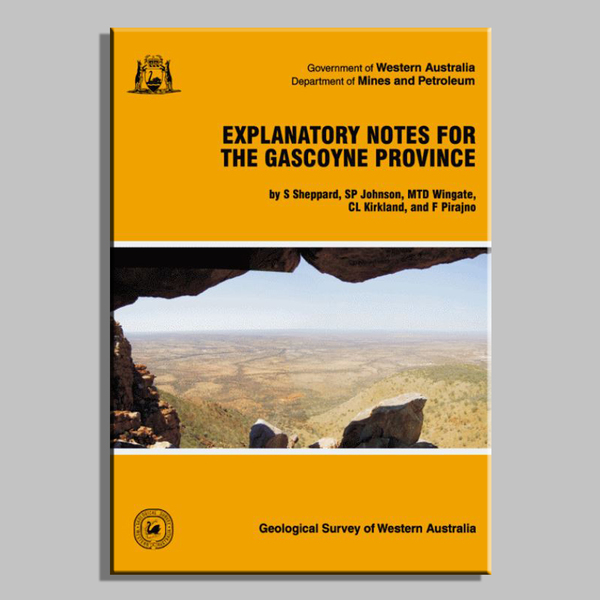 Explanatory notes 2010
Explanatory notes for the Gascoyne Province
Explanatory notes 2010
Explanatory notes for the Gascoyne Province
Records
-
 Record 2016/14
Mineralogy of gold from the Paulsens and Mount Olympus deposits, northern Capricorn Orogen, Western Australia
Record 2016/14
Mineralogy of gold from the Paulsens and Mount Olympus deposits, northern Capricorn Orogen, Western Australia
-
 Record 2013/12
The ironstone veins of the Gifford Creek ferrocarbonatite complex, Gascoyne Province
Record 2013/12
The ironstone veins of the Gifford Creek ferrocarbonatite complex, Gascoyne Province
-
 Record 2011/25
Capricorn Orogen seismic and magnetotelluric (MT) workshop 2011: extended abstracts
Record 2011/25
Capricorn Orogen seismic and magnetotelluric (MT) workshop 2011: extended abstracts
-
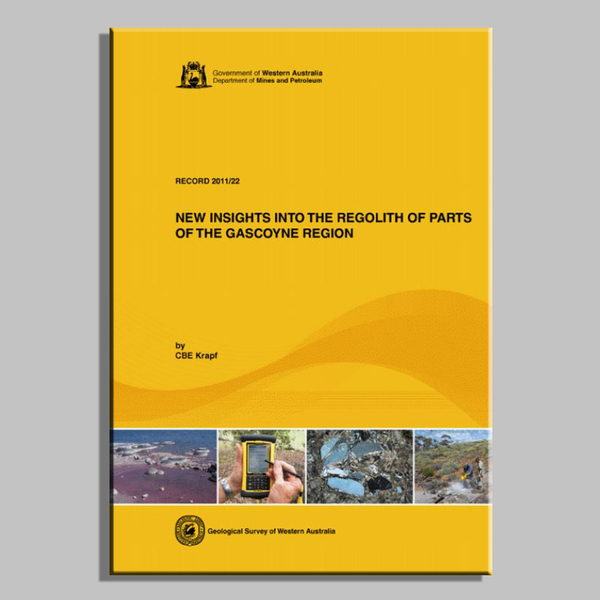 Record 2011/22
New insights into the regolith of parts of the Gascoyne region
Record 2011/22
New insights into the regolith of parts of the Gascoyne region
-
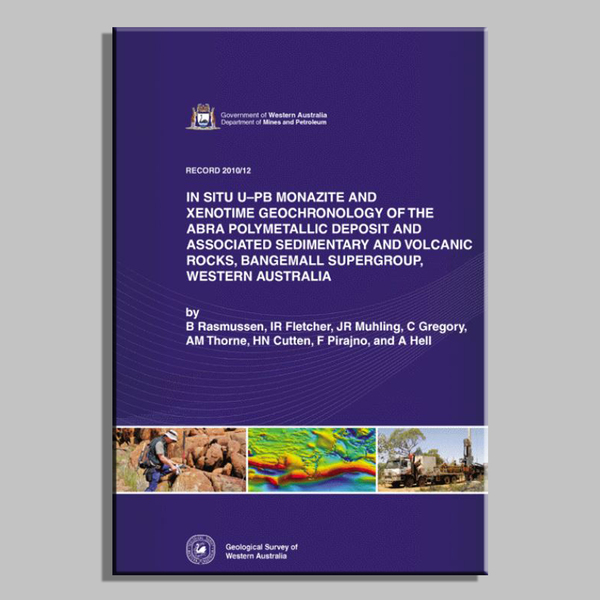 Record 2010/12
In situ U–Pb monazite and xenotime geochronology of the Abra polymetallic deposit
Record 2010/12
In situ U–Pb monazite and xenotime geochronology of the Abra polymetallic deposit
-
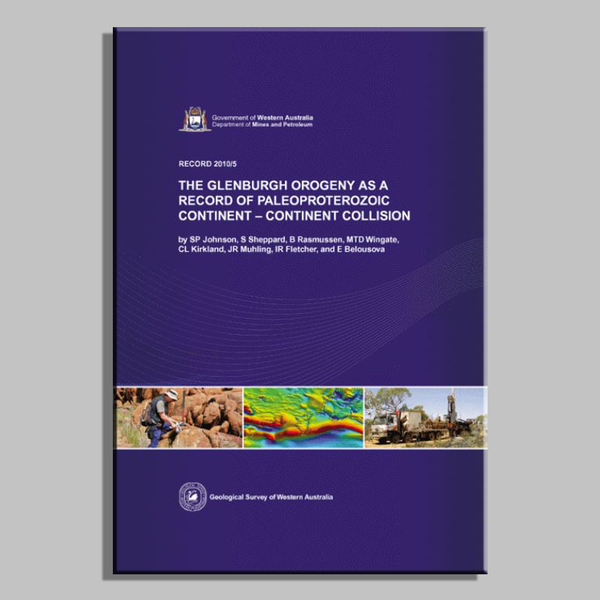 Record 2010/5
The Glenburgh Orogeny as a record of Paleoproterozoic continent–continent collision
Record 2010/5
The Glenburgh Orogeny as a record of Paleoproterozoic continent–continent collision
-
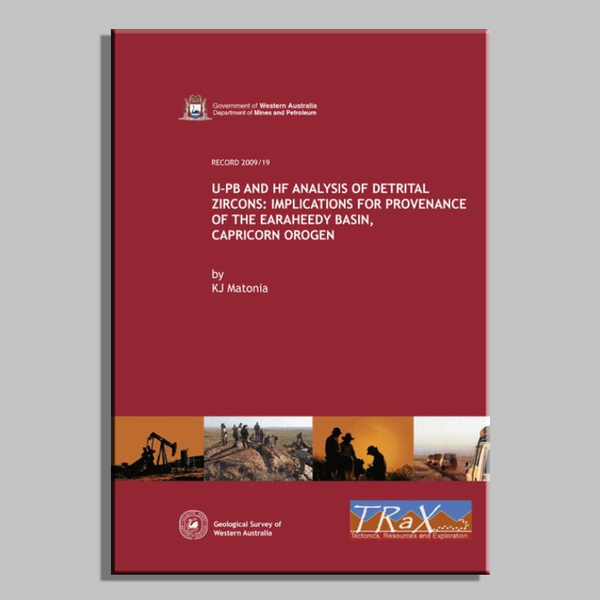 Record 2009/19
U–Pb and Hf analysis of detrital zircons: Implications for provenance of the Earaheedy Basin, Capricorn Orogen
Record 2009/19
U–Pb and Hf analysis of detrital zircons: Implications for provenance of the Earaheedy Basin, Capricorn Orogen
-
 Record 2009/6
Mineralogy and trace element chemistry of lode and alluvial gold from the western Capricorn Orogen
Record 2009/6
Mineralogy and trace element chemistry of lode and alluvial gold from the western Capricorn Orogen
-
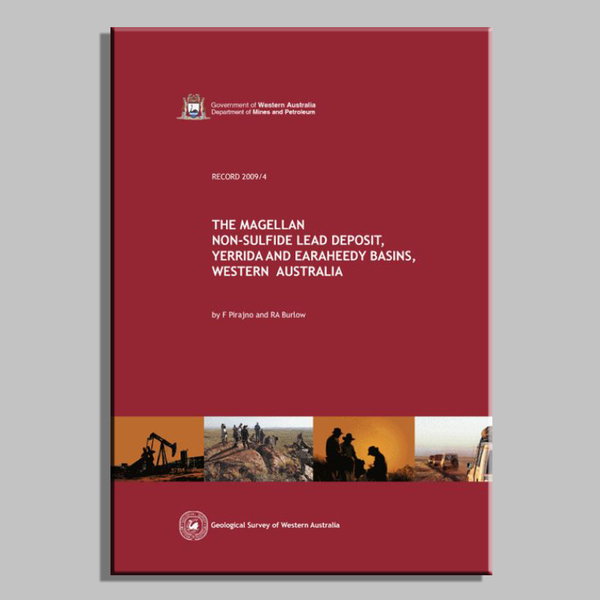 Record 2009/4
The Magellan non-sulfide lead deposit, Yerrida and Earaheedy Basins
Record 2009/4
The Magellan non-sulfide lead deposit, Yerrida and Earaheedy Basins
-
 Record 2007/16
Magnetotelluric investigation into the electrical structure of the Capricorn Orogen, Western Australia
Record 2007/16
Magnetotelluric investigation into the electrical structure of the Capricorn Orogen, Western Australia
-
 Record 2007/10
Neoproterozoic reworking in the Paleoproterozoic Capricorn Orogen: Evidence from 40Ar/39Ar ages
Record 2007/10
Neoproterozoic reworking in the Paleoproterozoic Capricorn Orogen: Evidence from 40Ar/39Ar ages
-
 Record 2006/18
Proterozoic geology of the western Capricorn Orogen — a field guide
Record 2006/18
Proterozoic geology of the western Capricorn Orogen — a field guide
-
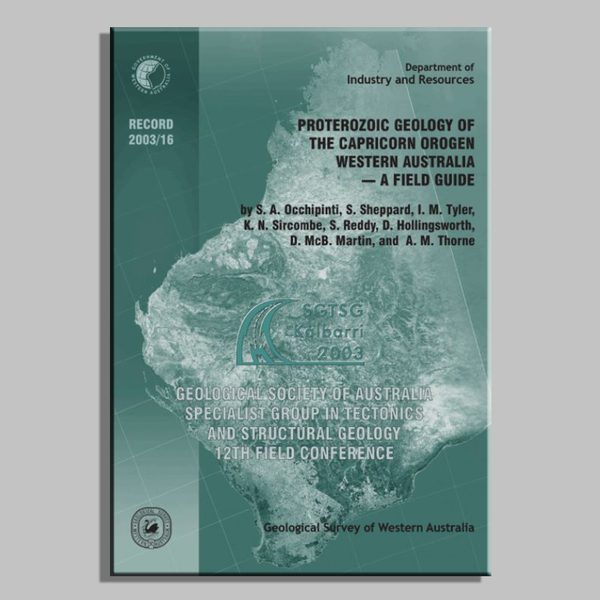 Record 2003/16
Proterozoic geology of the Capricorn Orogen, Western Australia — a field guide
Record 2003/16
Proterozoic geology of the Capricorn Orogen, Western Australia — a field guide
-
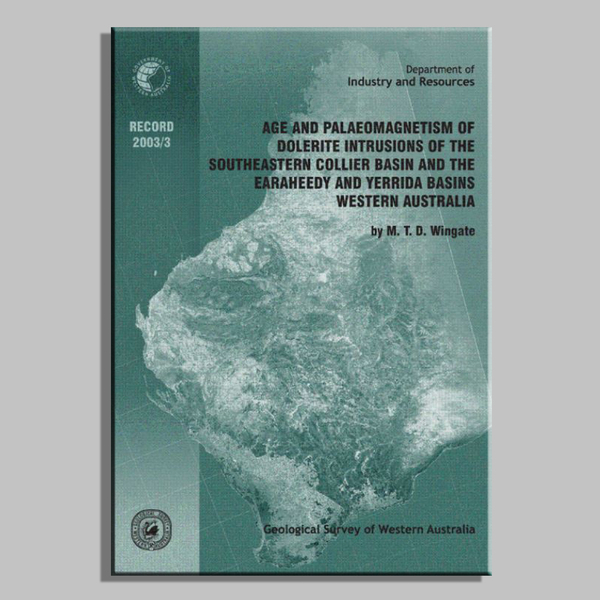 Record 2003/3
Age and palaeomagnetism of dolerite intrusions of the southeastern Collier Basin, and the Earaheedy and Yerrida Basins, Western Australia
Record 2003/3
Age and palaeomagnetism of dolerite intrusions of the southeastern Collier Basin, and the Earaheedy and Yerrida Basins, Western Australia
Maps
-
 Western Capricorn, 2016
Western Capricorn, 2016 Geological Information Series
Western Capricorn, 2016
Western Capricorn, 2016 Geological Information Series
-
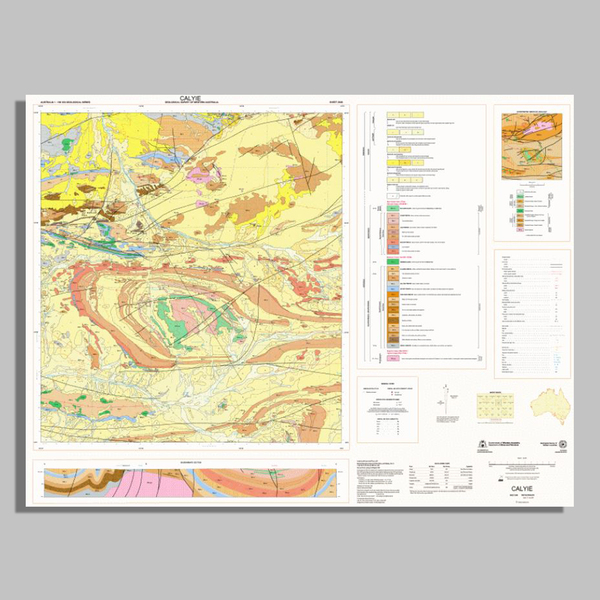 CALYE WA Sheet 2648
CALYE WA Sheet 2648
-
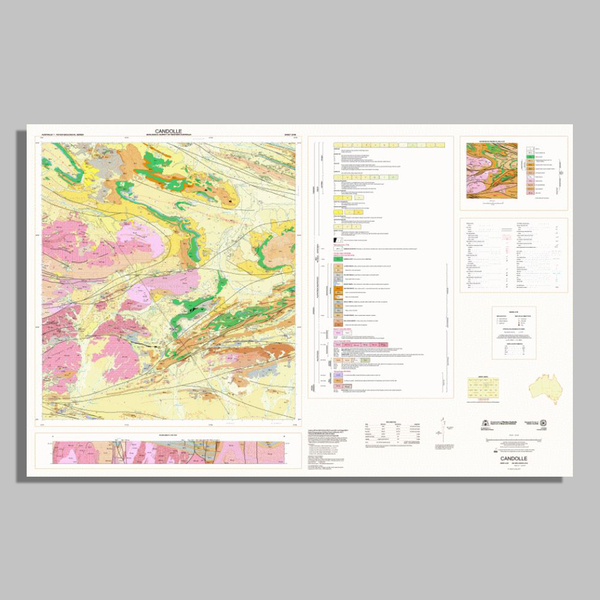 CANDOLLE WA Sheet 2348 (2nd edition)
CANDOLLE WA Sheet 2348 (2nd edition)
-
 CAPRICORN WA Sheet 2251
CAPRICORN WA Sheet 2251
-
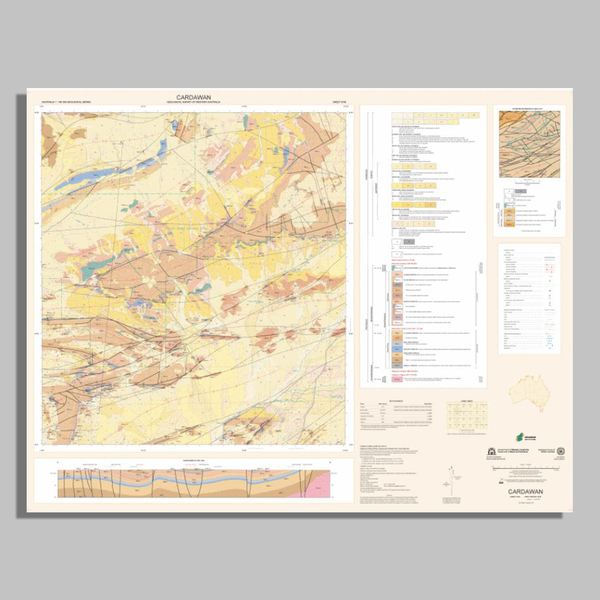 CARDAWAN WA Sheet 2748
CARDAWAN WA Sheet 2748
-
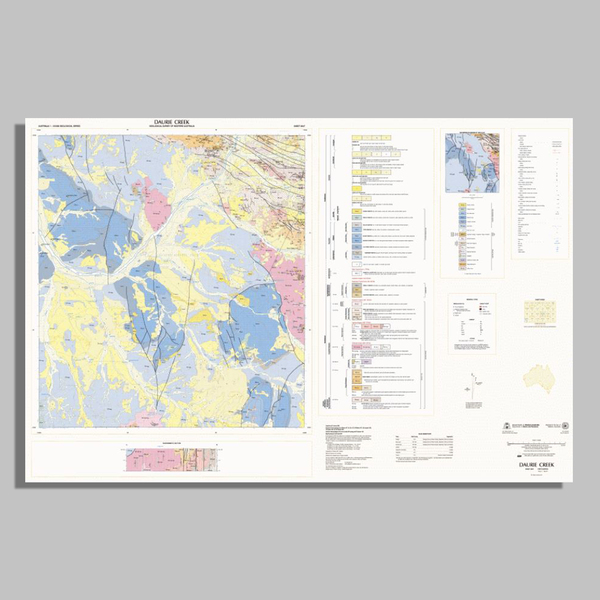 DAURIE CREEK WA Sheet 2047
DAURIE CREEK WA Sheet 2047
-
 EDMUND WA Sheet 2150 (Version 2.0)
EDMUND WA Sheet 2150 (Version 2.0)
-
 EDMUND WA Sheet SF 50-14 (2nd edition) 1:250 000
EDMUND WA Sheet SF 50-14 (2nd edition) 1:250 000
-
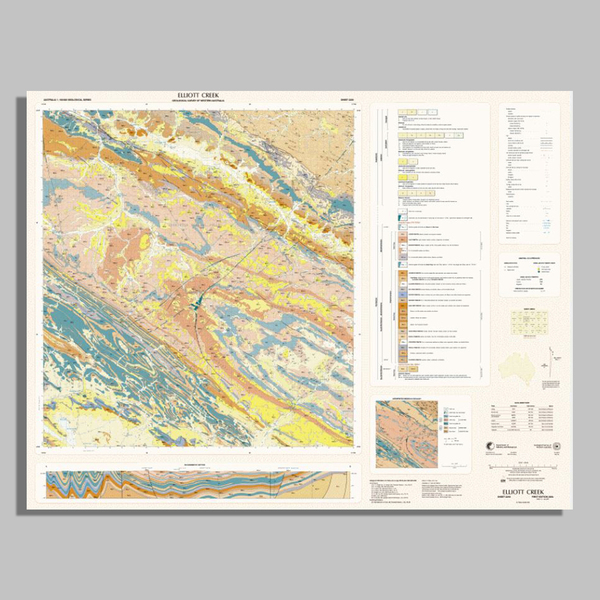 ELLIOT CREEK WA Sheet 2250
ELLIOT CREEK WA Sheet 2250
-
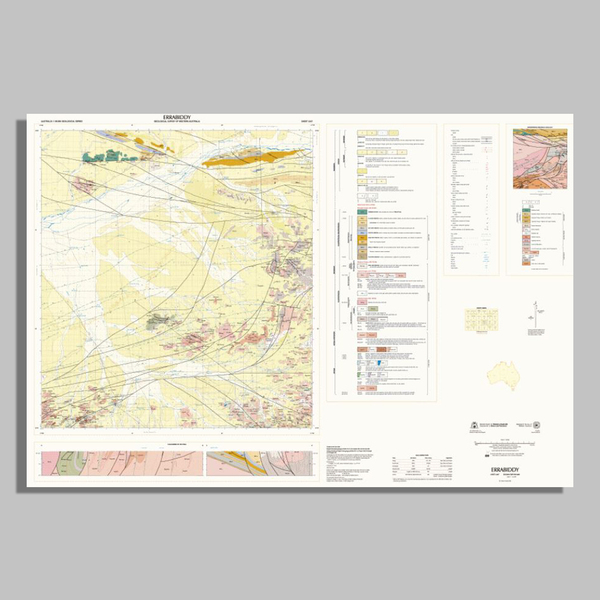 ERRABIDDY WA Sheet 2347 (2nd edition)
ERRABIDDY WA Sheet 2347 (2nd edition)
-
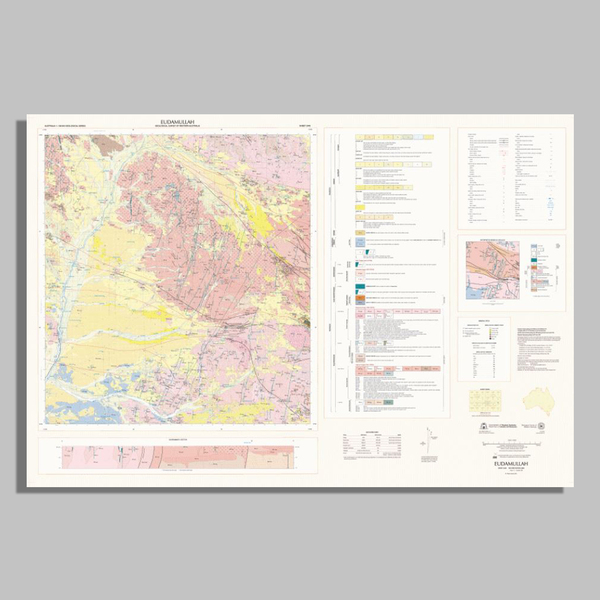 EUDAMULLAH WA Sheet 2049 (2nd edition)
EUDAMULLAH WA Sheet 2049 (2nd edition)
-
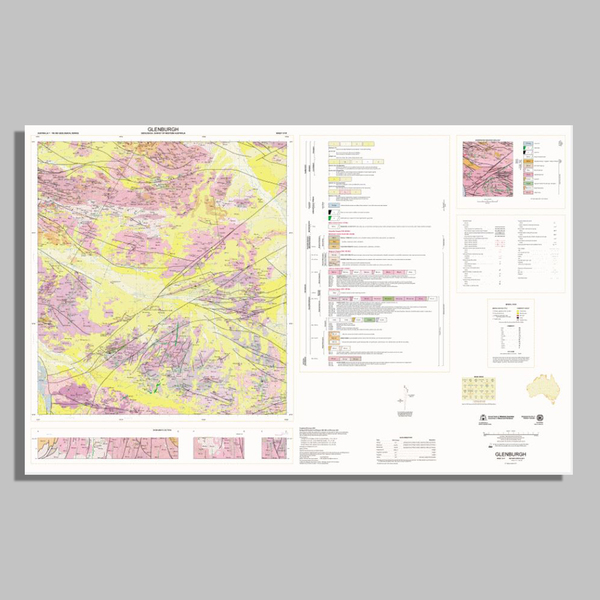 GLENBURGH WA Sheet 2147 (2nd edition)
GLENBURGH WA Sheet 2147 (2nd edition)
-
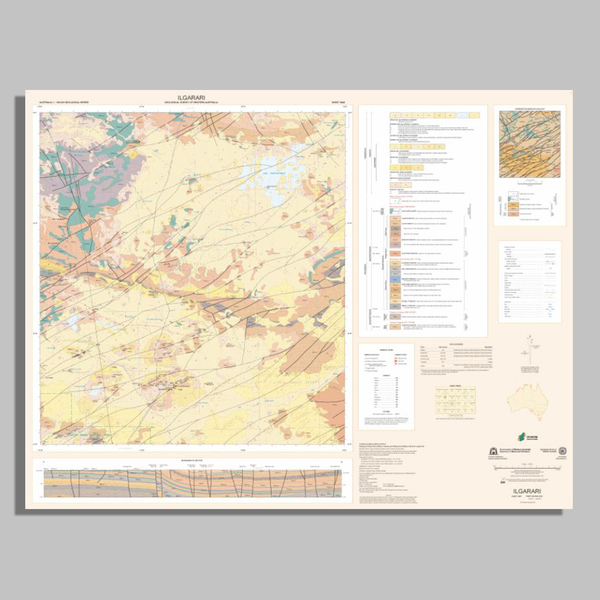 ILGARARI WA Sheet 2849
ILGARARI WA Sheet 2849
-
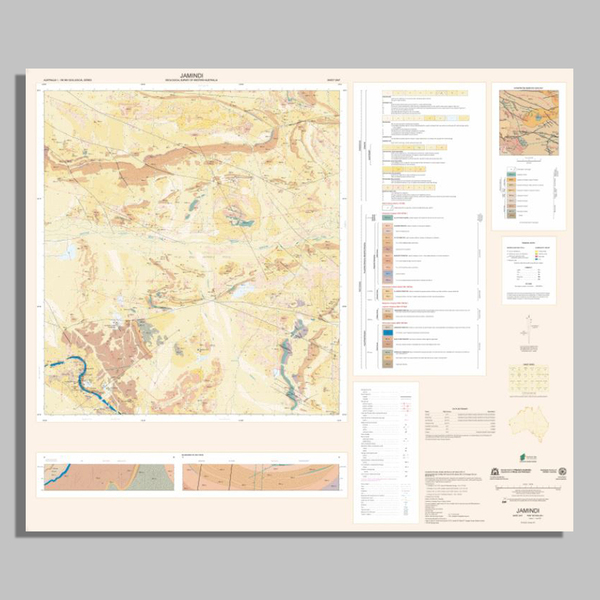 JAMINDI WA sheet 2647
JAMINDI WA sheet 2647
-
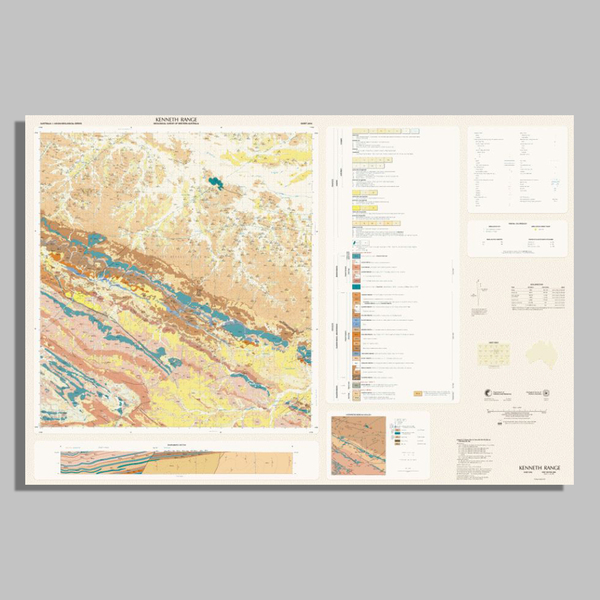 KENNETH RANGE WA Sheet 2350
KENNETH RANGE WA Sheet 2350
-
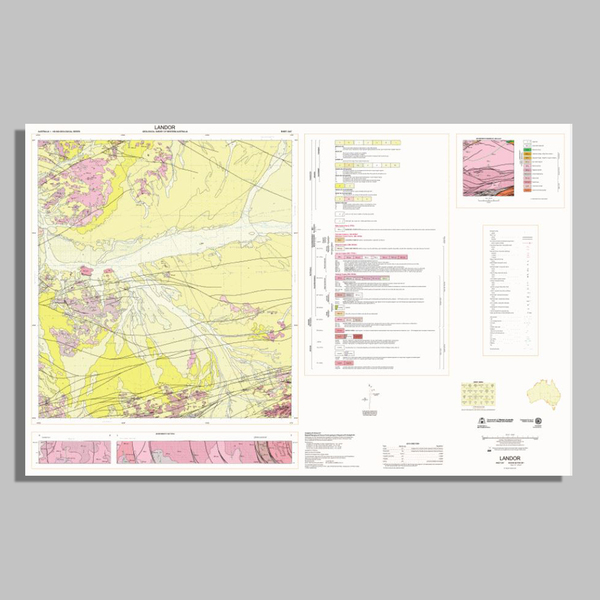 LANDOR WA Sheet 2247 (2nd edition)
LANDOR WA Sheet 2247 (2nd edition)
-
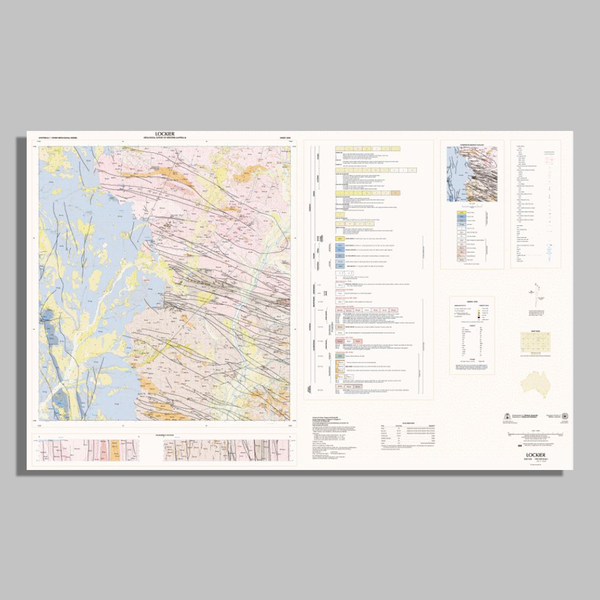 LOCKIER WA Sheet 2048
LOCKIER WA Sheet 2048
-
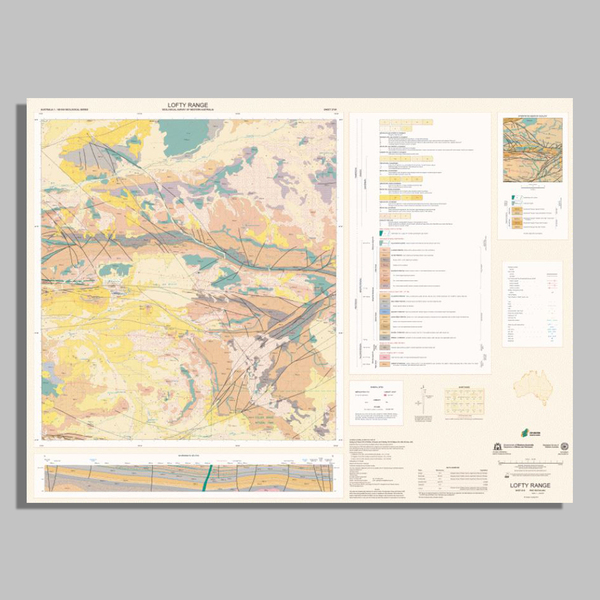 LOFTY RANGE WA Sheet 2749
LOFTY RANGE WA Sheet 2749
-
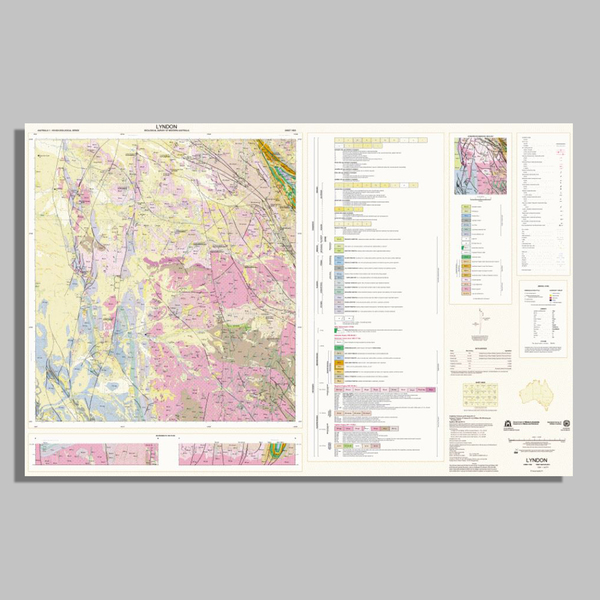 LYNDON WA sheet 1950
LYNDON WA sheet 1950
-
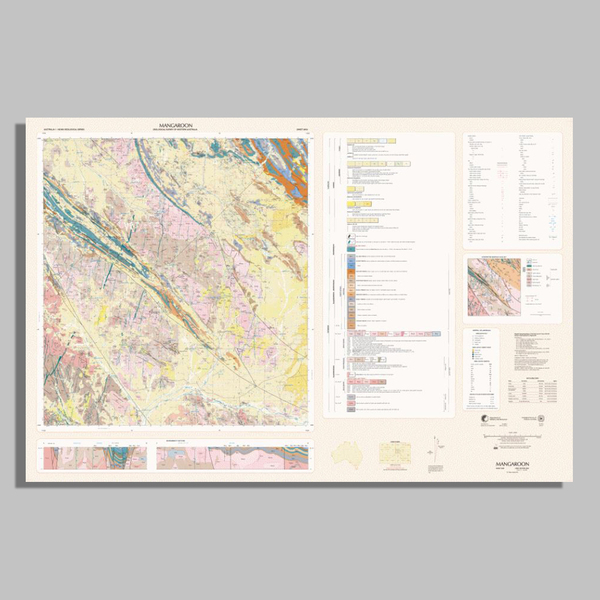 MANGAROON WA Sheet 2050
MANGAROON WA Sheet 2050
-
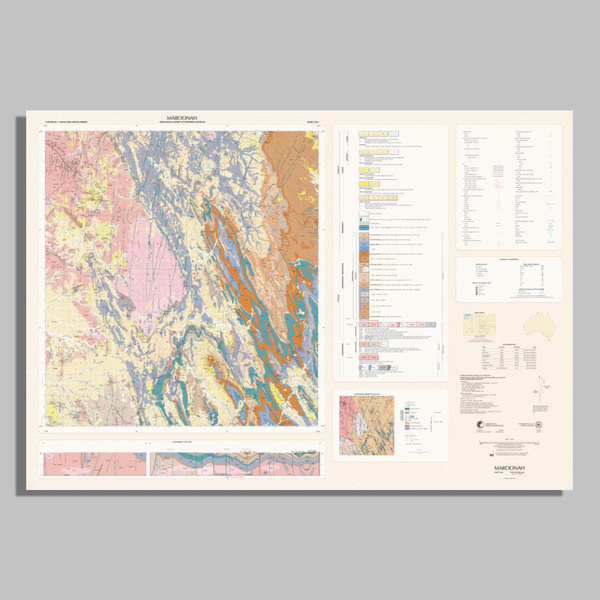 MAROONAH WA Sheet 2051
MAROONAH WA Sheet 2051
-
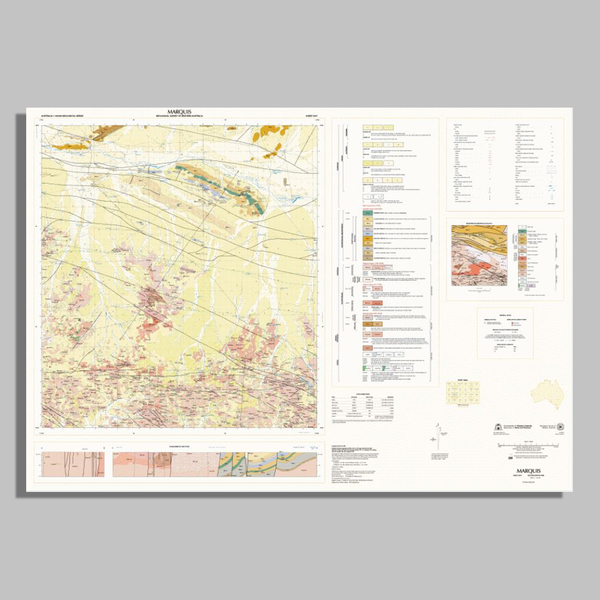 MARQUIS WA Sheet 2447 (2nd edition)
MARQUIS WA Sheet 2447 (2nd edition)
-
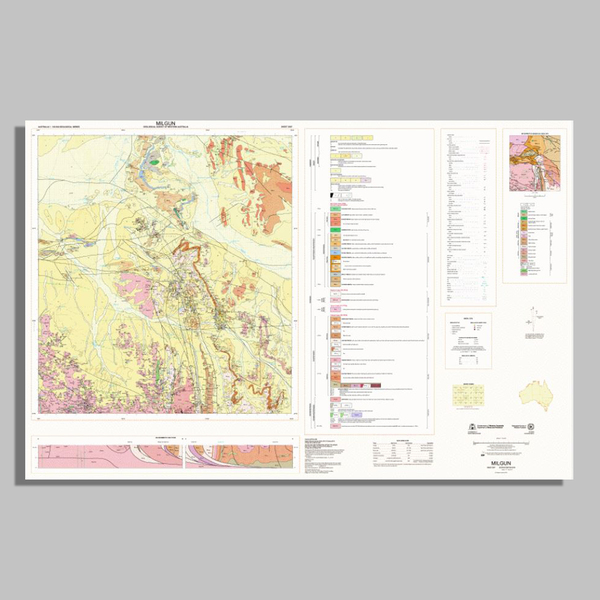 MILGUN WA Sheet 2547 (2nd edition)
MILGUN WA Sheet 2547 (2nd edition)
-
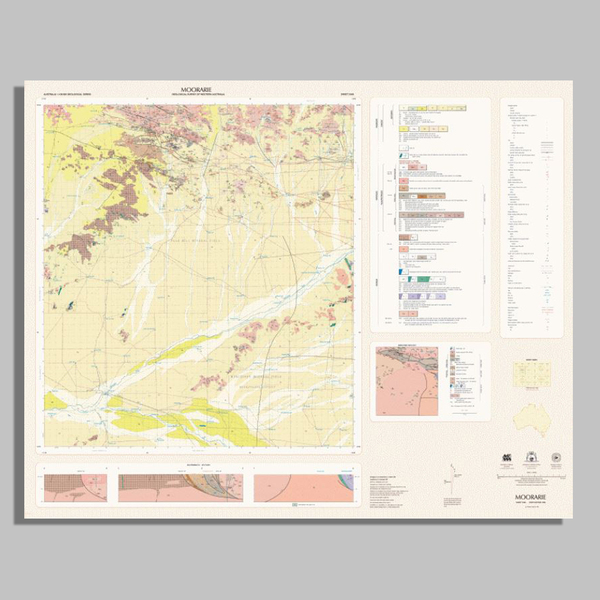 MOORARIE WA Sheet 2446
MOORARIE WA Sheet 2446
-
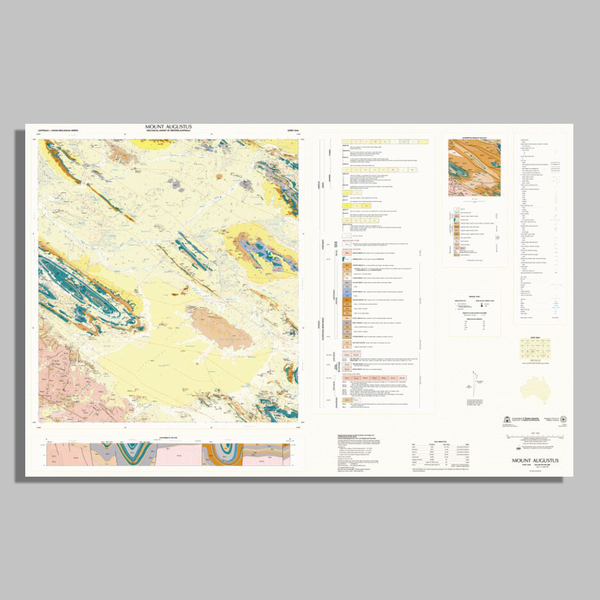 MOUNT AUGUSTUS WA Sheet 2249 (2nd edition)
MOUNT AUGUSTUS WA Sheet 2249 (2nd edition)
-
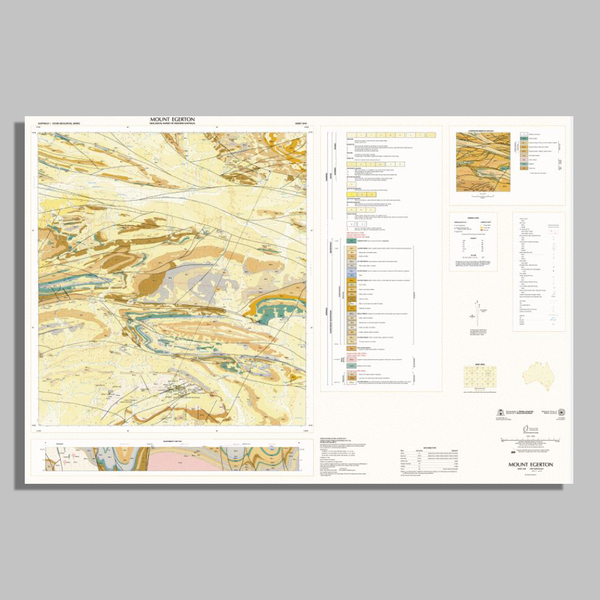 MOUNT EGERTON WA Sheet 2448
MOUNT EGERTON WA Sheet 2448
-
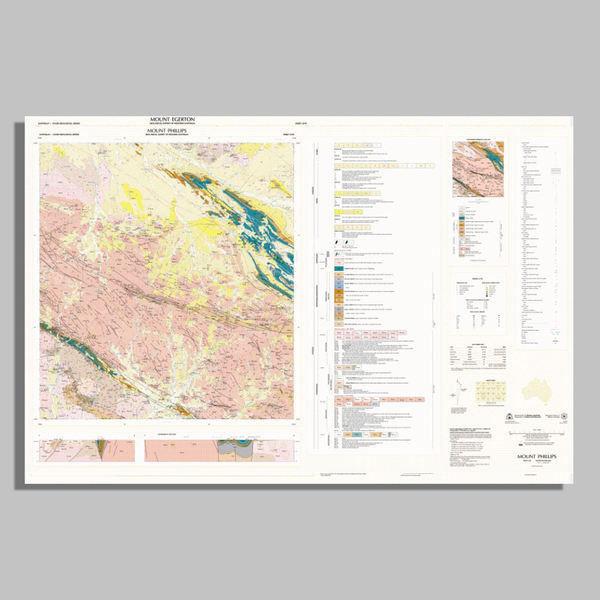 MOUNT PHILLIPS WA Sheet 2149 (2nd edition)
MOUNT PHILLIPS WA Sheet 2149 (2nd edition)
-
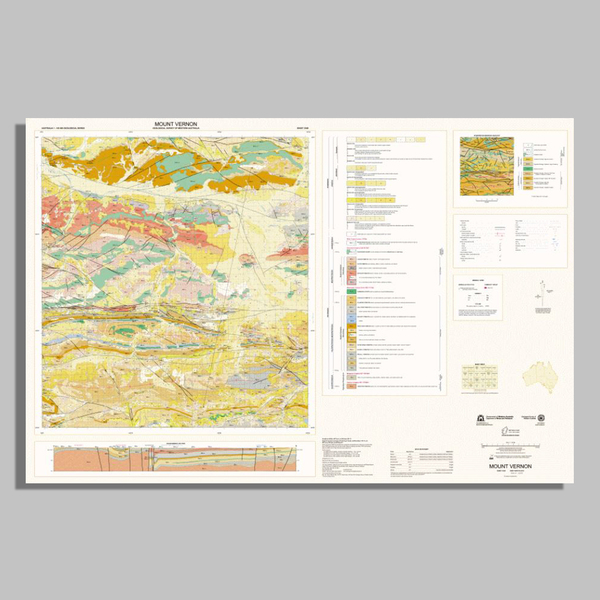 MOUNT VERNON WA Sheet 2549
MOUNT VERNON WA Sheet 2549
-
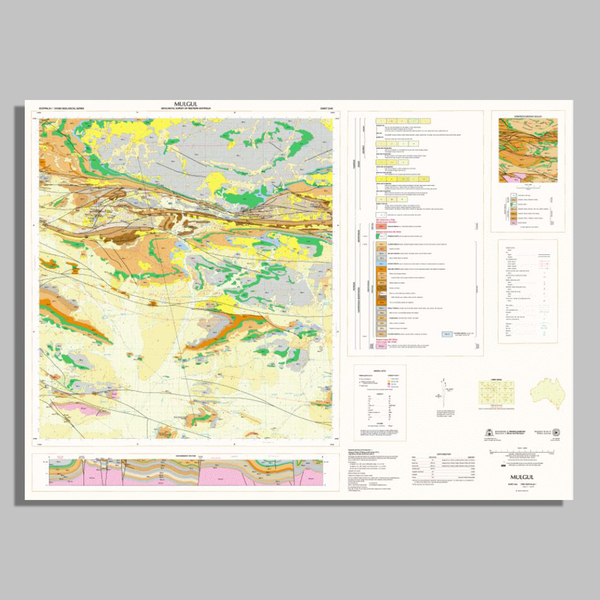 MULGUL WA Sheet 2548
MULGUL WA Sheet 2548
-
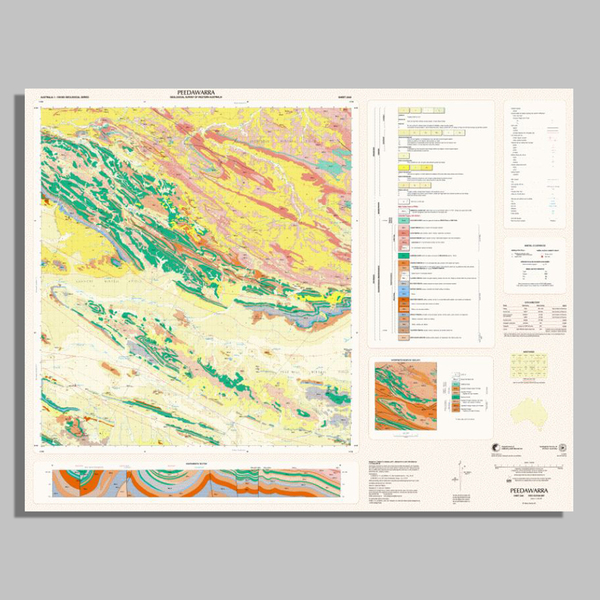 PEEDAWARRA WA Sheet 2349
PEEDAWARRA WA Sheet 2349
-
 PINK HILLS WA Sheet 2248
PINK HILLS WA Sheet 2248
-
 TANGADEE WA Sheet 2649
TANGADEE WA Sheet 2649
-
 TEANO WA Sheet 2449 (Version 2.0)
TEANO WA Sheet 2449 (Version 2.0)
-
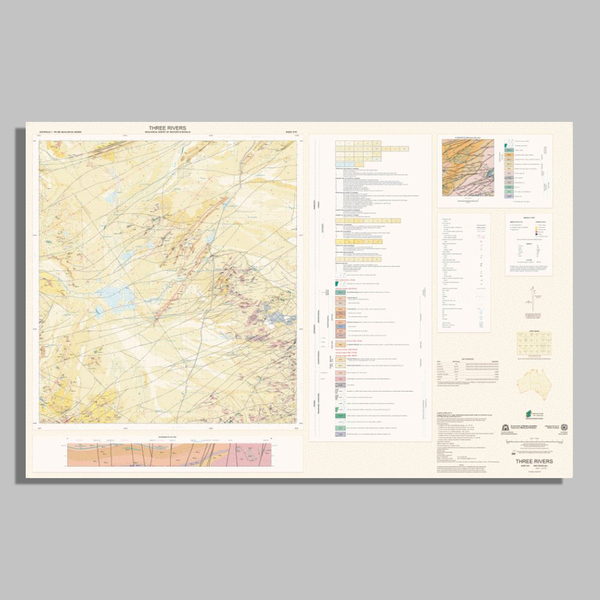 THREE RIVERS WA sheet 2747
THREE RIVERS WA sheet 2747
-
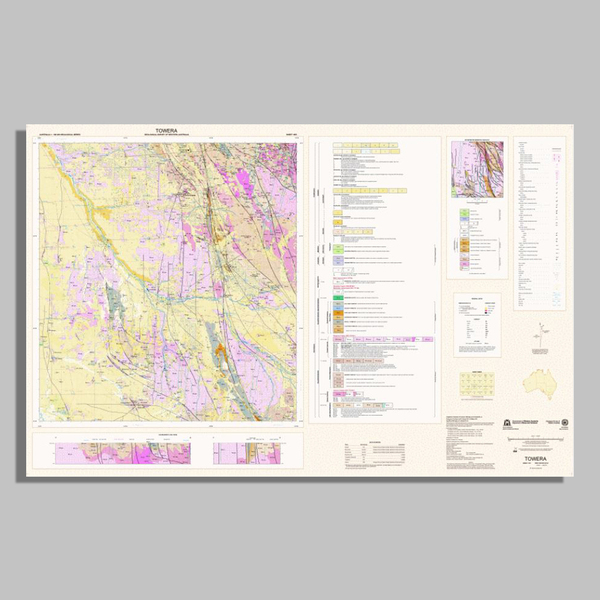 TOWERA WA Sheet 1951
TOWERA WA Sheet 1951
-
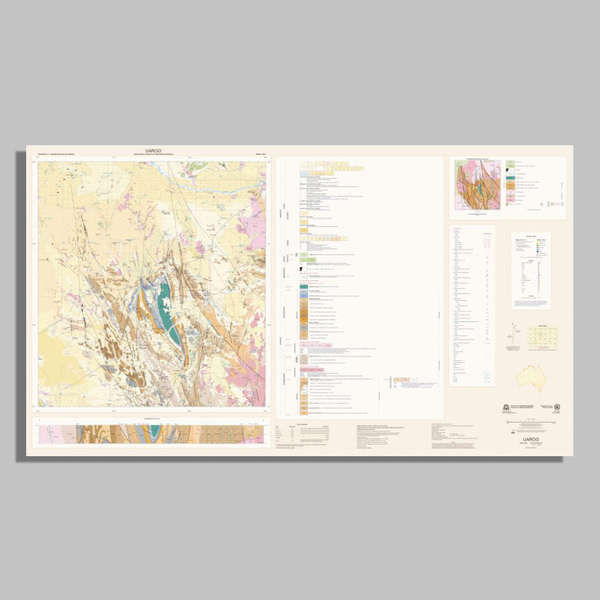 UAROO WA Sheet 1952
UAROO WA Sheet 1952
-
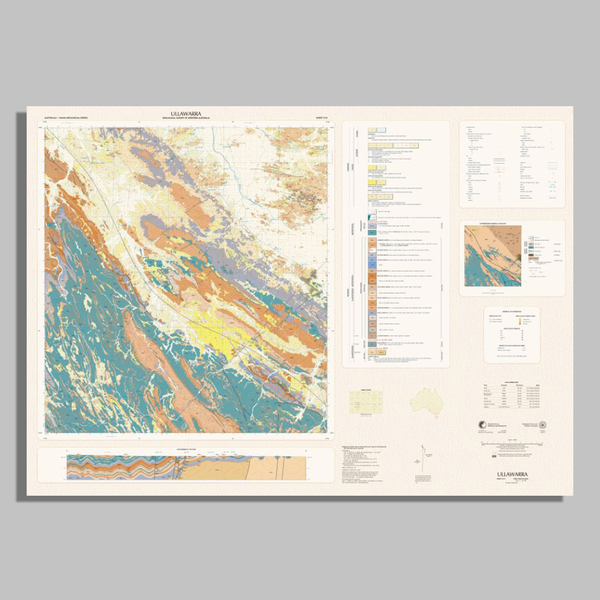 ULLAWARRA WA Sheet 2151
ULLAWARRA WA Sheet 2151
-
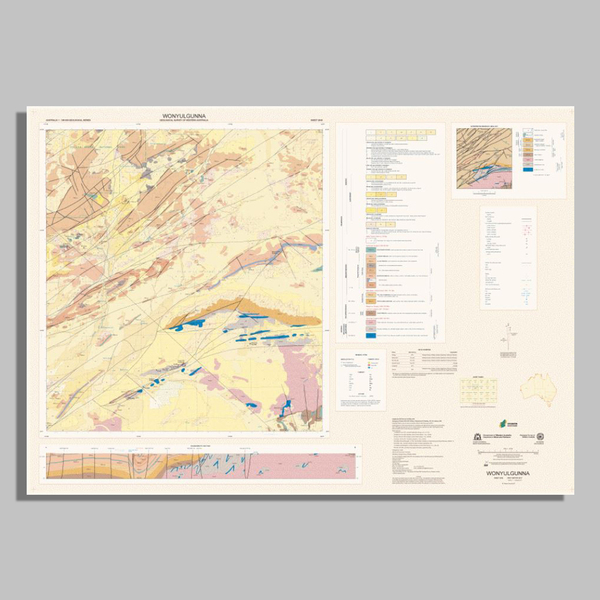 WONYULGUNNA WA Sheet 2848
WONYULGUNNA WA Sheet 2848
-
 YINNETHARRA WA Sheet 2148 (Version 2.0)
YINNETHARRA WA Sheet 2148 (Version 2.0)
Further publications
| 2018 |
Extensional episodes in the Paleoproterozoic Capricorn Orogen, Western Australia, revealed by petrogenesis and geochronology of mafic–ultramafic rocks |
Olierook, HKH, Sheppard, S, Johnson, SP, Occhipinti, SA, Reddy, SM, Clark, C, Fletcher, IR, Rasmussen, B, Zi, Z-W, Pirajno, F, LaFlamme, C, Do, T, Ware, B, Blandthorn, E, Lindsay, M, Lu, Y-J, Crossley, RJ and Erikson, TM Precambrian Research, 306, 22–40 doi:10.1016/j.precamres.2017.12.015 |
| 2017 | The tectonics and mineral systems of Proterozoic Western Australia: Relationships with supercontinents and global secular change |
Aitken, ARA, Occhipinti, SA, Lindsay, MD, Joly, A, Howard, HM, Johnson, SP, Hollis, JA, Spaggiari, CV, Tyler, IM, McCuaig, TC and Dentith, MC Geoscience Frontiers, 9, 295–316 doi:10.1016/j.gsf.2017.05.008 |
| 2017 | Paleoproterozoic basin development on the northern Yilgarn Craton, Western Australia |
Occhipinti, SA, Hocking, RM, Lindsay, MD, Aitken, ARA, Copp, I, Jones, J, Sheppard, S, Pirajno, F and Metelka, V Precambrian Research, 300, 121–140 doi:10.1016/j.precamres.2017.08.003 |
| 2017 | Monazite trumps zircon: applying SHRIMP U–Pb geochronology to systematically evaluate emplacement ages of leucocratic, low-temperature granites in a complex Precambrian orogen |
Piechocka, AM., Gregory, CJ., Zi, J–W, Sheppard, S, Wingate, MTD and Rasmussen, B Contributions to Mineralogy and Petrology, 172, 63p doi:10.1007/s00410-017-1386-5 |
| 2017 | Using In Situ SHRIMP U–Pb Monazite and Xenotime Geochronology to Determine the Age of Orogenic Gold Mineralization: An Example from the Paulsens Mine, Southern Pilbara Craton |
Fielding, IOH, Johnson, SP, Zi, J–W, Rasmussen, B, Muhling, JR., Dunkley, DJ, Sheppard, S, Wingate, MTD and Rogers, JR Economic Geology, 112, 1205–1230 doi:10.5382/econgeo.2017.4507 |
| 2017 | An isotopic perspective on growth and differentiation of Proterozoic orogenic crust: From subduction magmatism to cratonization |
Johnson, SP, Korhonen, FJ, Kirkland, CL, Cliff, JB, Belousova, EA and Sheppard, S Lithos, 268, 76–86 doi:10.1016/j.lithos.2016.11.003 |
| 2017 |
Radiogenic heating and craton-margin plate stresses as drivers for intraplate orogeny |
Korhonen, FJ, Johnson, SP, Wingate, MTD, Kirkland, CL, Fletcher, IR, Dunkley, DJ, Roberts, MP, Sheppard, S, Muhling, JR and Rasmussen, B Journal of Metamorphic Geology, 35, 631–661 doi:10.1111/jmg.12249 |
| 2017 |
The evolution of a Precambrian arc-related granulite facies gold deposit: Evidence from the Glenburgh deposit, Western Australia |
Roche, LK, Korhonen, FJ, Johnson, SP, Wingate, MTD, Hancock, EA, Dunkley, DJ, Zi, Z–W, Rasmussen, B., Muhling, JR, Occhipinti, SA, Dunbar, M and Goldsworthy, J Precambrian Research, 290, 63–85 doi:10.1016/j.precamres.2016.12.007 |
| 2016 | A new Paleoproterozoic tectonic history of the eastern Capricorn Orogen, Western Australia, revealed by U–Pb zircon dating of micro-tuffs |
Sheppard, S, Fletcher, IR, Rasmussen, B, Zi, J–W, Muhling, JR, Occhipinti, SA, Wingate, MTD and Johnson, SP Precambrian Research, 286, 1–19 doi:10.1016/j.precamres.2016.09.026 |
| 2015 | The role of radiogenic heat in prolonged intraplate reworking: The Capricorn Orogen explained? |
Korhonen, FJ and Johnson, SP Earth and Planetary Science Letters, 428, 22–32 doi:10.1016/j.epsl.2015.06.039 |
| 2015 | In situ U–Pb geochronology of xenotime and monazite from the Abra polymetallic deposit in the Capricorn Orogen, Australia: dating hydrothermal mineralization and fluid flow in a long-lived crustal structure |
Zi, J–W, Rasmussen, B, Muhling, JR, Fletcher, IR, Thorne, AM, Johnson, SP, Cutten, HN, Dunkley, DJ and Korhonen, FJ Precambrian Research, 260, 91–112 doi:10.1016/j.precamres.2015.01.010 |
| 2014 | The Gifford Creek Ferrocarbonatite Complex, Gascoyne Province, Western Australia: Associated fenitic alteration and a putative link with the ~1075 Ma Warakurna LIP |
Pirajno, F, González-Álvarez, I, Chen, W, Kyser, KT, Simonetti, A, Leduc, E and leGras, M Lithos, 202–203, 100–119 doi:10.1016/j.lithos.2014.05.012 |
| 2013 |
Crustal architecture of the Capricorn Orogen, Western Australia from deep crustal reflection data |
Johnson, SP, Thorne, AM, Korsch, RJ, Tyler, IM, Kennett, BLN, Cutten, HN, Blay, O, Blewett, RS, Goodwin, J, Holzschuh, J, Salmon, M, Dentith, MC, Aitken, ARA, Joly, A, Reading, A, Boren, G, Ross, J Costelloe, RD and Fomin, T Australian Journal of Earth Sciences, 60, 681–705 doi:10.1080/08120099.2013.826735 |
| 2012 | Seismic structure of the crust and uppermost mantle of the Capricorn and Paterson orogens and adjacent cratons, Western Australia, from passive seismic transects |
Reading, AM, Tkalcic, H, Kennett, BLN, Johnson, SP and Sheppard, S Precambrian Research, v. 196–197, 295–308 doi:10.1016/j.precamres.2011.07.001 |
| 2011 | Two collisions, two sutures: Punctuated pre-1950 Ma assembly of the West Australian Craton during the Ophthalmian and Glenburgh Orogenies |
Johnson, SP, Sheppard, S, Rasmussen, B, Wingate, MTD, Kirkland, CL, Muhling, JR, Fletcher, IR and Belousova, EA Precambrian Research, 189, 239–262 doi:10.1016/j.precamres.2011.07.011 |
| 2010 | Tectonic setting and regional implications of ca 2.2 Ga mafic magmatism in the southern Hamersley Province, Western Australia |
Martin, DMcB and Morris, PA Australian Journal of Earth Sciences, 57, 911–931 doi:10.1080/08120099.2010.510172 |
| 2010 |
The Magellan Pb deposit, Western Australia: a new category within the class of supergene non-sulphide mineral systems |
Pirajno, F, Burlow, R and Huston, DL Ore Geology Reviews, 37, 101–113 doi:10.1016/j.oregeorev.2010.01.001 |
| 2009 | Identifying the lithospheric structure of a Precambrian orogen using magnetotellurics: the Capricorn Orogen, Western Australia |
Selway, K, Sheppard, S, Thorne, AM, Johnson, SP and Groenewald, PB Precambrian Research, 168, 185–196 doi:10.1016/j.precamres.2008.09.010 |
| 2009 | A review of the geology and geodynamic evolution of the Palaeoproterozoic Earaheedy Basin, Western Australia |
Pirajno, F, Hocking, RM, Reddy, S and Jones AJ Earth-Science Reviews, 94, 39–77 doi:10.1016/j.earscirev.2009.03.003 |
| 2009 | Chemical fingerprinting of multiple large-scale magmatic events in the Mesoproterozoic Bangemall Supergroup, Western Australia |
Morris, PA and Pirajno, F Australian Journal of Earth Sciences, 56, 985–1001 doi:10.1080/08120090903112091 |
| 2008 | Provenance history of the Bangemall Supergroup and implications for the Mesoproterozoic paleogeography of the West Australian Craton |
Martin, DMcB, Sircombe, KN, Thorne, AM, Cawood, PA and Nemchin AA Precambrian Research, 166, 93–110 doi:10.1016/j.precamres.2007.07.027 |
| 2008 | Role of geochronology in our present-day understanding of the Proterozoic: an Australian perspective |
Sheppard, S, Rasmussen, B, Bodorkos, S and Tyler, IM Australian Journal of Earth Sciences, 55, 795–819 doi:10.1080/08120090802097393 |
| 2007 | Grenvillian-aged orogenesis in the Palaeoproterozoic Gascoyne Complex, Western Australia: 1030–950 Ma reworking of the Proterozoic Capricorn Orogen |
Sheppard, S, Rasmussen, B, Muhling, JR, Farrell, TR and Fletcher, IR Journal of Metamorphic Geology, 25, 477–494 doi:10.1111/j.1525-1314.2007.00708.x |
| 2005 | Intracontinental reworking in the Capricorn Orogen, Western Australia: the 1680–1620 Ma Mangaroon Orogeny |
Sheppard, S, Occhipinti, SA and Nelson, DR Australian Journal of Earth Sciences, 52, 443–460 doi:10.1080/08120090500134589 |
| 2004 | Assembling and reactivating the Proterozoic Capricorn Orogen: lithotectonic elements, orogenies, and significance |
Cawood, PA and Tyler, IM Precambrian Research, 128, 201–218 doi:10.1016/j.precamres.2003.09.001 |
| 2004 |
A 2005–1970 Ma Andean-type batholith in the southern Gascoyne Complex, Western Australia |
Sheppard, S, Occhipinti, SA and Tyler, IM Precambrian Research, 128, 257–277 doi:10.1016/j.precamres.2003.09.003 |
| 2004 | Geology and tectonic evolution of Palaeoproterozoic basins of the eastern Capricorn Orogen, Western Australia |
Pirajno, F, Jones, JA, Hocking, RM and Halilovic, J Precambrian Research, 128, 315–342 doi:10.1016/j.precamres.2003.09.006 |
| 2004 | Provenance of the Earaheedy Basin: implications for assembly of the Western Australian Craton |
Halilovic, J, Cawood, PA, Jones, JA, Pirajno, F and Nemchin, AA Precambrian Research, 128, 315–342 doi:10.1016/j.precamres.2003.09.007 |
| 2004 | Tectonic setting and basin evolution of the Bangemall Supergroup in the northwestern Capricorn Orogen |
Martin, DMcB and Thorne, AM Precambrian Research, 128, 385–409 doi:10.1016/j.precamres.2003.09.009 |
| 2004 | Metallogeny in the Capricorn Orogen, Western Australia, the result of multiple ore-forming processes |
Pirajno, F Precambrian Research, 128, 411–439 doi:10.1016/j.precamres.2003.09.010 |
| 2004 | Oceanic plateau accretion onto the northwestern margin of the Yilgarn Craton, Western Australia: implications for a mantle plume event at ca. 2.0 Ga |
Pirajno, F Journal of Geodynamics, 37, 205–231 doi:10.1016/j.jog.2004.02.003 |
| 2004 | Warakurna large igneous province: A new Mesoproterozoic large igneous province in west-central Australia |
Wingate, MTD, Pirajno, F and Morris, PA Geology, 32(2), 105–108 doi:10.1130/G20171.1 |
| 2003 | The relationship between tectonism and composition of granitoid magmas, Yarlarweelor Gneiss Complex, Western Australia |
Sheppard, S, Occhipinti, SA and Tyler IM Lithos, 66, 133–154 doi:10.1016/S0024-4937(02)00216-5 |
| 2002 | Chert in the Palaeoproterozoic Bartle Member, Killara Formation, Yerrida Basin, Western Australia: a rift-related playa lake and thermal spring environment? |
Pirajno, F and Grey, K Precambrian Research, 113, 169–192 doi:10.1016/S0301-9268(01)00196-6 |
| 2000 | Three Palaeoproterozoic basins—Yerrida, Bryah and Padbury—Capricorn Orogen, Western Australia |
Pirajno, F and Occhipinti, SA Australian Journal of Earth Sciences, 47, 675–688 doi:10.1046/j.1440-0952.2000.00800.x |
| 1999 | Pseudomorphs after evaporitic minerals interbedded with 2.2 Ga stromatolites of the Yerrida basin, Western Australia: Origin and significance |
Tabakh, ME, Grey, K, Pirajno, F and Schrieber, BC Geology, 27(10), 871–874 doi:10.1130/0091-7613(1999)027<0871:PAEMIW>2.3.CO;2 |
| 1998 | Syntectonic granite in the southern margin of the Palaeoproterozoic Capricorn Orogen, Western Australia |
Occhipinti, SA, Sheppard, S, Nelson, DR, Myers, JS and Tyler, IM Australian Journal of Earth Sciences, 45, 509–512 doi:10.1080/08120099808728408 |
| 1998 | Geology and tectonic evolution of the Palaeoproterozoic Bryah, Padbury and Yerrida Basins (formerly Glengarry Basin), Western Australia: implications for the history of the south-central Capricorn Orogen |
Pirajno, F, Occhipinti, SA and Swager, CP Precambrian Research, 90, 119–140 doi:10.1016/S0301-9268(98)00045-X |
| 1998 | Structural-metamorphic evolution of the Palaeoproterozoic Bryah and Padbury Groups during the Capricorn orogeny, Western Australia |
Occhipinti, SA, Swager, CP and Pirajno, F Precambrian Research, 90, 141–158 doi:10.1016/S0301-9268(98)00046-1 |
| 1990 | The northern margin of the Capricorn Orogen, Western Australia—an example of an Early Proterozoic collision zone |
Tyler, IM and Thorne AM Journal of Structural Geology, 12, 685–701 doi:10.1016/0191-8141(90)90082-A |
Acknowledgements
Much of this work is supported by the Western Australian Government Exploration Incentive Scheme.
Contact
For more information contact:
geological.survey@dmirs.wa.gov.au
